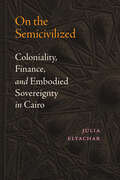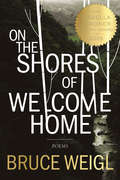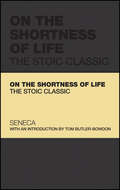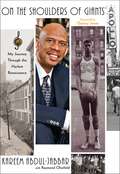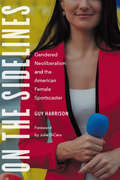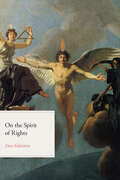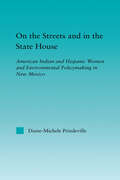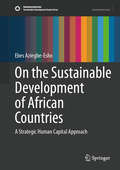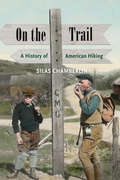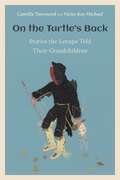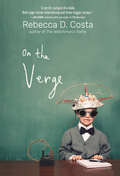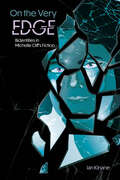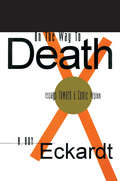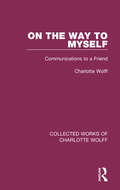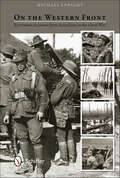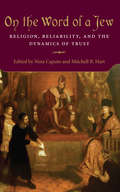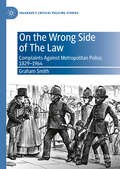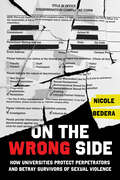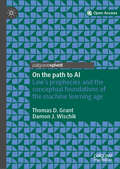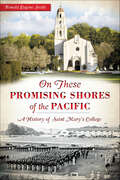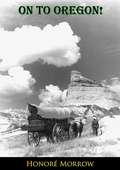- Table View
- List View
On the Screen: Displaying the Moving Image, 1926–1942 (Film and Culture Series)
by Ariel RogersToday, in a world of smartphones, tablets, and computers, screens are a pervasive part of daily life. Yet a multiplicity of screens has been integral to the media landscape since cinema’s golden age. In On the Screen, Ariel Rogers rethinks the history of moving images by exploring how experiments with screen technologies in and around the 1930s changed the way films were produced, exhibited, and experienced.Marshalling extensive archival research, Rogers reveals the role screens played at the height of the era of “classical” Hollywood cinema. She shows how filmmakers, technicians, architects, and exhibitors employed a variety of screens within diverse spaces, including studio soundstages, theaters, homes, stores, and train stations. Far from inert, screens served as means of structuring mediated space and time, contributing to the transformations of modern culture. On the Screen demonstrates how particular approaches to the use of screens traversed production and exhibition, theatrical and extratheatrical practice, mainstream and avant-garde modes, and even cinema and television. Rogers’s history challenges conventional narratives about the novelty of the twenty-first-century multiscreen environment, showing how attention to the variety of historical screen practices opens up new ways to understand contemporary media.
On the Semicivilized: Coloniality, Finance, and Embodied Sovereignty in Cairo
by Julia ElyacharOn the Semicivilized by Julia Elyachar is a sweeping analysis of the coloniality that shaped—and blocked—sovereign futures for those dubbed barbarian and semicivilized in the former Ottoman Empire. Drawing on thirty years of ethnographic research in Cairo, family archives from Palestine and Egypt, and research on Ottoman debt and finance to rethink catastrophe and potentiality in Cairo and the world today, Elyachar theorizes a global condition of the “semicivilized” marked by nonsovereign futures, crippling debts, and the constant specter of violence exercised by those who call themselves civilized. Originally used to describe the Ottoman Empire, whose perceived “civilizational differences” rendered it incompatible with a Western-dominated global order, semicivilized came to denote lands where unitary territorial sovereignty was stymied at the end of WWI. Elyachar’s theorizing offers a new analytic vocabulary for thinking beyond territoriality, postcolonialism, and the “civilized"/"primitive” divide. Looking at the world from the perspective of the semicivilized, Elyachar argues, allows us to shift attention to embodied infrastructures, collective lives, and practices of moving and acting in common that bypass lingering assumptions of territorialism and unitary sovereign rule.
On the Shores of Welcome Home (American Poets Continuum #176)
by Bruce WeiglIn this Isabella Gardner Award-winning collection of poems, Bruce Weigl meditates on the ghosts and the grace one encounters in life’s second act. A celebrated poet and veteran of the Vietnam War, Weigl offers a nuanced sense of aging as a departure and death as a returning home. With a sage’s eye for mindfulness and a soldier’s longing for the country where he served, Weigl’s poems reveal the long scars left by Vietnam and the new possibilities one encounters in the wake of life-altering experiences.
On the Shortness of Life
by Lucius Annaeus SenecaThroughout history, some books have changed the world. They have transformed the way we see ourselves--and each other. They have inspired debate, dissent, war and revolution. They have enlightened, outraged, provoked and comforted. They have enriched lives--and destroyed them. Now, Penguin brings you the works of the great thinkers, pioneers, radicals and visionaries whose ideas shook civilization, and helped make us who we are. Penguin's Great Ideas series features twelve groundbreaking works by some of history's most prodigious thinkers, and each volume is beautifully packaged with a unique type-drive design that highlights the bookmaker's art. Offering great literature in great packages at great prices, this series is ideal for those readers who want to explore and savor the Great Ideas that have shaped the world. The Stoic writings of the philosopher Seneca offer powerful insights into the art of living, the importance of reason and morality, and continue to provide profound guidance to many through their eloquence, lucidity and timeless wisdom. .
On the Shortness of Life: The Stoic Classic (Capstone Classics)
by Lucius Annaeus Seneca Tom Butler-BowdonMake each of your days meaningful using Seneca's immortal guidance In On the Shortness of Life: The Stoic Classic, Tom Butler-Bowdon introduces the work of Lucius Annaeus Seneca, an ancient Roman philosopher who wrote on the fleeting nature of existence and the need to live in a way that is worthy of the short time we have on this planet. In the book, you'll learn how to go beyond busyness and shallow pursuits and fill your days with purpose. The happy life is the virtuous life. Seneca explains how to: Spend time in reflection and truly honour yourself and your value. Fulfil your duties to family and society yet remain mentally independent. Separate what matters from what merely pleases the ego. Perfect for anyone seeking meaning and purpose in their daily lives, On the Shortness of Life is an extraordinary reminder of the transient nature of life that shows you how to make each moment count.
On the Shoulders of Giants: My Journey Through the Harlem Renaissance
by Kareem Abdul-JabbarNew York Times bestselling author and living legend Kareem Abdul-Jabbar shares how the power of the Harlem Renaissance led him to become the man he is today—basketball superstar, jazz enthusiast, historian, and Black American icon.In On the Shoulders of Giants, Kareem Abdul-Jabbar invites us on an extraordinarily personal journey back to his birthplace of Harlem through one of the greatest political, cultural, literary, and artistic movements in history. He reveals the tremendous impact the Harlem Renaissance had on both American culture and his own life. Travel deep into the soul of the Renaissance—the night clubs, restaurants, basketball games, and fabulous parties that have made footprints in Harlem&’s history. Meet the athletes, jazz musicians, comedians, actors, politicians, entrepreneurs, and writers who not only inspired Kareem&’s rise to greatness but an entire nation.
On the Sidelines: Gendered Neoliberalism and the American Female Sportscaster (Sports, Media, and Society)
by Guy HarrisonWhen sports fans turn on the television or radio today, they undoubtedly find more women on the air than ever before. Nevertheless, women sportscasters are still subjected to gendered and racialized mistreatment in the workplace and online and are largely confined to anchor and sideline reporter positions in coverage of high-profile men&’s sports. In On the Sidelines Guy Harrison weaves in-depth interviews with women sportscasters, focus groups with sports fans, and a collection of media products to argue that gendered neoliberalism—a cluster of exclusionary twenty-first-century feminisms—maintains this status quo. Spinning a cohesive narrative, Harrison shows how sportscasting&’s dependence on gendered neoliberalism broadly places the onus on women for their own success despite systemic sexism and racism. As a result, women in the industry are left to their own devices to navigate double standards, bias in hiring and development for certain on-air positions, harassment, and emotional labor. Through the lens of gendered neoliberalism, On the Sidelines examines each of these challenges and analyzes how they have been reshaped and maintained to construct a narrow portrait of the ideal neoliberal female sportscaster. Consequently, these challenges are taken for granted as &“natural,&” sustaining women&’s marginalization in the sportscasting industry.
On the Spirit of Rights (The Life of Ideas)
by Dan EdelsteinBy the end of the eighteenth century, politicians in America and France were invoking the natural rights of man to wrest sovereignty away from kings and lay down universal basic entitlements. Exactly how and when did “rights” come to justify such measures? In On the Spirit of Rights, Dan Edelstein answers this question by examining the complex genealogy of the rights that regimes enshrined in the American and French Revolutions. With a lively attention to detail, he surveys a sprawling series of debates among rulers, jurists, philosophers, political reformers, writers, and others who were all engaged in laying the groundwork for our contemporary systems of constitutional governance. Every seemingly new claim about rights turns out to be a variation on a theme, as late medieval notions were subtly repeated and refined to yield the talk of “rights” we recognize today. From the Wars of Religion to the French Declaration of the Rights of Man and of the Citizen to the 1948 Universal Declaration of Human Rights, On the Spirit of Rights is a sweeping tour through centuries of European intellectual history and an essential guide to our ways of thinking about human rights today.
On the Strange Place of Religion in Contemporary Art
by James ElkinsCan contemporary art say anything about spirituality? John Updike calls modern art "a religion assembled from the fragments of our daily life," but does that mean that contemporary art is spiritual? What might it mean to say that the art you make expresses your spiritual belief? On the Strange Place of Religion in Contemporary Art explores the curious disconnection between spirituality and current art. This book will enable you to walk into a museum and talk about the spirituality that is or is not visible in the art you see.
On the Streets and in the State House: American Indian and Hispanic Women and Environmental Policymaking in New Mexico (Indigenous Peoples and Politics)
by Diane-Michele PrindevilleFirst Published in 2004. Routledge is an imprint of Taylor & Francis, an informa company.
On the Suffering of the World (Penguin Great Ideas Ser. #Vol. 14)
by Arthur SchopenhauerOn the Suffering of the World is a collection of the later aphoristic writings of Arthur Schopenhauer, known for their incisive, aphoristic style and dark, pessimistic view of human existence.Edited and with an introduction by Eugene Thacker, On the Suffering of the World comprises a core selection of Schopenhauer's later writings, gathered together for the first time in print. These texts, produced during the last decades of Schopenhauer's long life, reveal a unique kind of philosophy, expressed in a singular style. Eschewing the tradition of dry, totalizing, academic philosophy prevalent during the time, Schopenhauer's later writings mark a shift towards a philosophy of aphorisms, fragments, anecdotes and observations, written in a literary style that is by turns antagonistic, resigned, confessional, and filled with all the fragile contours of an intellectual memoir. Here Schopenhauer allows himself to pose challenging questions regarding the fate of the human species, the role of suffering in the world, and the rift between self and world that increasingly has come to define human existence, to this day. It is these writings of Schopenhauer that later generations of artists, poets, musicians, and philosophers would identify as exemplifying the pessimism of their era, and perhaps of our own as well. On the Suffering of the World is presented with an introduction that places Schopenhauer's thought in its intellectual context, while also connecting it to contemporary concerns over climate change, the anthropocene, and the spectre of human extinction. The book also includes a bibliography and chronology of Schopenhauer's life.
On the Sustainable Development of African Countries: A Strategic Human Capital Approach (Sustainable Development Goals Series)
by Ebes Aziegbe-EshoDespite Africa’s vast and diverse natural resources, the developmental challenges plaguing the continent still remain. Indeed, a common factor that seems to bind all African countries together is developmental problems and challenges. From North Africa to Southern Africa, across West Africa through to Central and East Africa, African countries, especially those in Sub-Saharan Africa, are faced with the same or similar developmental challenges. Many reasons have been offered for Africa’s developmental challenges. Amongst developmental economists, the reasons range from geographical, historical, cultural, and tribal factors, to institutional factors. The unfavourable geographical landscape, its colonial and other peculiar histories, the huge diversity in culture and tribe that seem to hinder efforts at unity, and lack of good governance and the institutions of quality governance, have all been given as reasons for the inability of the continent to make good developmental progress. This book offers a strategic human capital approach as a pathway to the sustainable development of African countries. The book synthesizes different knowledge domains on human capital, and presents ways on how human capital can be strategically developed and accumulated by African countries for sustainable development. The book highlights how the continent’s growing youthful population can be strategically harnessed into human capital for sustainable development. Unlike other books on human capital and Africa’s development that rely on a single disciplinary perspective, usually from economics, this book takes a multi-disciplinary and inter-disciplinary approach. The book draws from theories and studies of human capital in economics, the originating discipline of the concept, strategic management, entrepreneurship, and Strategic Human Resources Management. Thus, it is able to present the discuss and recommendations from a holistic integration of the concept of human capital. The book also presents case studies of three countries, Singapore, Finland, and Canada, that have successfully made strategic use of human capital in their national development in different ways; another unique feature of the book. Lessons on national human capital development are drawn from each case study. Another unique feature of the book is its integration of the various global human capital indices available for a comprehensive understanding of the indices, their components, and utility for countries. Finally, the book is replete with many generic and specific recommendations on how human capital can be developed by various stake holders in Africa. A whole chapter is dedicated to generic strategic approaches to human capital development that can be adopted by African countries; and indeed, by all countries as they can be applied by other countries. The generic approaches are cumulatively drawn from resource-based theory (RBT), transaction cost economics, and human capital theory. Another chapter is also dedicated to more specific recommendations on human capital development and accumulation.
On the Trail: A History of American Hiking
by Silas ChamberlinThe first history of the American hiking community and its contributions to the nation&’s vast network of trails. In the mid-nineteenth century urban walking clubs emerged in the United States. A little more than a century later, tens of millions of Americans were hiking on trails blazed in every region of the country. This groundbreaking book is the first full account of the unique history of the American hiking community and its rich, nationwide culture. Delving into unexplored archives, including those of the Appalachian Mountain Club, Sierra Club, Green Mountain Club, and many others, Silas Chamberlin recounts the activities of hikers who over many decades formed clubs, built trails, and advocated for environmental protection. He also discusses the shifting attitudes of the late 1960s and early 1970s when ideas about traditional volunteerism shifted and new hikers came to see trail blazing and maintenance as government responsibilities. Chamberlin explores the implications for hiking groups, future club leaders, and the millions of others who find happiness, inspiration, and better health on America&’s trails. &“With rich historical context Silas Chamberlin inspires new appreciation for trailblazers, while sharing the legacy of hiking and its growing importance today, as people find their way to a new relationship with the natural world.&”—Richard Louv, author of Last Child in the Woods and Vitamin N &“Chamberlin has demonstrated that what at first looks simple—walking on our own two feet—has a complex history of changing cultural associations, social infrastructure, and national significance.&”—James Longhurst, University of Wisconsin – La Crosse
On the Turtle's Back: Stories the Lenape Told Their Grandchildren (CERES: Rutgers Studies in History)
by Camilla Townsend Nicky Kay MichaelThe Lenape tribe, also known as the Delaware Nation, lived for centuries on the land that English colonists later called New Jersey. But once America gained its independence, they were forced to move further west: to Indiana, then Missouri, and finally to the territory that became Oklahoma. These reluctant migrants were not able to carry much from their ancestral homeland, but they managed to preserve the stories that had been passed down for generations. On the Turtle’s Back is the first collection of Lenape folklore, originally compiled by anthropologist M. R. Harrington over a century ago but never published until now. In it, the Delaware share their cherished tales about the world’s creation, epic heroes, and ordinary human foibles. It features stories told to Harrington by two Lenape couples, Julius and Minnie Fouts and Charles and Susan Elkhair, who sought to officially record their legends before their language and cultural traditions died out. More recent interviews with Lenape elders are also included, as their reflections on hearing these stories as children speak to the status of the tribe and its culture today. Together, they welcome you into their rich and wondrous imaginative world.
On the Verge
by Rebecca D. CostaThe author of The Watchman&’s Rattle &“has done it again. On the Verge shows how predictive technologies and science are redefining modern leadership&” (George Mitchell, former Senate Majority Leader). &“There can be no greater advantage than certainty of the future. Not in nature. Not in business. Not in governance.&” So begins Rebecca Costa&’s much-awaited exploration of foresight: &“the crowning achievement of human ambition.&” According to Costa, advances in Big Data, predictive analytics, genomics, artificial intelligence, and other breakthroughs have made it possible to pinpoint future results with mind-blowing accuracy—cracking the door to what Costa calls predaptation: the ability to adapt before the fact. Never before has the information needed to avert danger, get the jump ahead of others, or prepare for the inevitable been so clearly within grasp. Through fascinating real-life examples, Costa reveals how technology has brought nations, businesses, and individuals to the edge of clairvoyance. Yet, our ability to act on foreknowledge often falls short—causing leaders to squander the advantage of preemption. To counteract this failure, Costa illuminates 12 principles of adaptation, and predaptation, used to succeed in fast-moving environments. In the spirit of the best in popular science, On the Verge is a landmark examination of big-picture forces affecting society today. Costa&’s unique sociobiological perspective, combined with her ability to blend humor, breaking science, and insightful personal stories, distinguishes her as one of the most important thought leaders of our time. &“If you have an insatiable curiosity about the impact of innovation on our world ahead and how the future can be manipulated, you will love this book.&”—John Sculley, former CEO of Apple and President of Pepsi-Cola
On the Very Edge: Bidentities in Michelle Cliff’s Fiction
by Ian KinaneOn the Very Edge: Bidentities in Michelle Cliff’s Fiction uses the life and work of bisexual, biracial, and bicultural author Michelle Cliff (1946–2016) to develop an entirely new approach to intersectional cultural, race, and gender/sexuality studies that prioritizes “bi-ness” as a methodological tool. The book focuses not “simply” on bisexuality, biracialism, or biculturalism as isolated identity concepts; rather, it explores the very nature of these intersectional identity categories as configured by Cliff. The text, therefore, represents a reclamation of bi identity in Cliff’s work as a much broader cultural, and not just sexual or racial, category, arguing that Cliff’s spaces and/or stages of “bi-ness” are in themselves significant in understanding contemporary global identity politics, as well as in navigating complex and often damaging identity constructs.Michelle Cliff, partnered with poet Adrienne Rich and “passing” as white, had an often-invisible sexuality and cultural identity. Yet her acclaimed work—Abeng, No Telephone to Heaven, Bodies of Water, If I Could Write This in Fire, Free Enterprise, and others—demonstrates the intersections between bisexuality, biracialism, and biculturalism in often profound ways. Drawing on original research, interviews, diaries, editorials, and other correspondences, On the Very Edge will have far-reaching implications in the understanding of complex Caribbean identity politics and intersectional race, gender, and sexuality studies at large.
On the Way to Death: Essays Toward a Comic Vision
by A. Roy EckardtOn the Way to Death completes Eckardt's astonishing trilogy on the interrelationship of comedy, death, and God. It addresses itself to the question of death as the basic incongruity of life. Here is opened to human view the final divine comedy: a total reversal of the traditional roles assigned to God and humankind, a comical denouncement of the terror of death. On the Way to Death follows Sitting in the Earth and Laughing and How to Tell God From the Devil to complete Roy Eckardt's trilogy on comedy, the devil, and God.
On the Way to Myself: Communications to a Friend (Collected Works of Charlotte Wolff #4)
by Charlotte WolffOriginally published in 1969, Dr Charlotte Wolff was the author of three books of psychology: The Human Hand, A Psychology of Gesture and The Hand in Psychological Diagnosis. This book, though it contains much psychology, is not of the same scientific kind as these. It is an autobiography, but not one of the normal kind. It is the history of a mind, not the chronicle of a life. For this reason it is not arranged chronologically but it is constructed round what the author called the creative shock experiences of her life, some of which belong with their consequences rather than with events adjacent in time. The resulting book is one of imaginative psychology. In the course of a life which began on the borders of Poland and carried her to Germany, France, Russia and England, Dr Wolff had met and known many of the most famous writers, artists and thinkers of the time. In Germany she studied under the founding Existentialists, Husserl and Heidegger; in France she carried out psychological research under Professor Henri Wallon and was also assisted by the Surrealists, André Breton, St. Exupéry, Paul Eluard; in England she was aided in her work by Sir Julian Huxley, Aldous Huxley and his wife, Dr William Stephenson, Dr Earle and others. But Dr Wolff’s earliest creative work was as a poet, and though she turned to psychology, her interest in art brought her into touch at different times with Ravel, Virginia Woolf, Bernard Shaw, Lady Ottoline Morrell, Thomas and Heinrich Mann, Baladine Klossowska and many more. Dr Earle wrote of her that she is ‘an artist of psychology’, and it is thus that she appears in this odd and fascinating book. Today it is an interesting glimpse in to the life of an early feminist psychologist. Her later research focused on sexology, her writing on lesbianism and bisexuality were influential early works in the field.
On the Western Front: Eyewitness Accounts from Australians in the Great War
by Michael EnrightHow Australian civilians came to the Western Front and why, in their own words
On the Word of a Jew: Religion, Reliability, and the Dynamics of Trust
by Edited by Nina Caputo and Mitchell B. HartFourteen essays examining the dynamics of trust and mistrust in Jewish history from biblical times to today. What, if anything, does religion have to do with how reliable we perceive one another to be? When and how did religious difference matter in the past when it came to trusting the word of another? In today&’s world, we take for granted that being Jewish should not matter when it comes to acting or engaging in the public realm, but this was not always the case. The essays in this volume look at how and when Jews were recognized as reliable and trustworthy in the areas of jurisprudence, medicine, politics, academia, culture, business, and finance. As they explore issues of trust and mistrust, the authors reveal how caricatures of Jews move through religious, political, and legal systems. While the volume is framed as an exploration of Jewish and Christian relations, it grapples with perceptions of Jews and Jewishness from the biblical period to today, from the Middle East to North America, and in Ashkenazi and Sephardi traditions. Taken together these essays reflect on the mechanics of trust, and sometimes mistrust, in everyday interactions involving Jews.&“Highly readable and compelling, this volume marks a broadly significant contribution to Jewish studies through the underexplored dynamic of trust.&” —Rebekah Klein-Pejšová, author of Mapping Jewish Loyalties in Interwar Slovakia&“An exemplary compendium on how to engage with a major concept—trust—while providing load of gripping new information, new theorization of otherwise well-covered material, and meticulous attention to textual and sociological sources.&” —Gil Anidjar, author of Blood: A Critique of Christianity
On the Wrong Side of The Law: Complaints Against Metropolitan Police, 1829-1964 (Palgrave's Critical Policing Studies)
by Graham SmithThis book, the first of a two volume study, provides an historical account of complaints against Metropolitan police officers between formation of the force in 1829 and codification of remedies for misconduct under the Police Act 1964. A complainant centred standpoint is developed to counteract the marginalization of the interests of victims, which is held to demonstrate that the drive for effective and efficient law enforcement has overshadowed the public interest in holding officers to account for misconduct. After officer accountability before the criminal courts diminished in the nineteenth century, missed opportunities to reform complaints procedures following commissions of inquiry in 1906-08, 1928 and 1960-62 are discussed. The second volume of the study, Combating Impunity: Complaints Against Metropolitan Police, 1964-2021, will examine the part played by complainants and civil society organisations in combating police impunity in the citizen oversight era.
On the Wrong Side: How Universities Protect Perpetrators and Betray Survivors of Sexual Violence
by Nicole BederaThis explosive investigation reveals the profound failures of the Title IX system and identifies concrete, surprisingly simple steps we can take to protect students. The debate over campus sexual violence is more heated than ever, but hardly anyone knows what actually happens inside Title IX offices. On the Wrong Side provides the first comprehensive account of the inner workings of the secretive Title IX system. Drawing on a yearlong study of survivors, perpetrators, and the administrators who oversaw their cases, sociologist Nicole Bedera exposes the structures that predictably punish survivors who come forward in the service of protecting—or even rewarding—their perpetrators. In doing so, she reveals that the system tasked with ending gender inequality on campus only intensifies it, upending survivors' lives and threatening the degrees that brought them to college in the first place. Equally heartbreaking and optimistic, On the Wrong Side makes it easy to imagine life-changing interventions for the next generation of students by proposing specific solutions to the structural problems of Title IX. Bedera proves that ending campus sexual violence is within our grasp—and dares us to be courageous enough to take action.
On the path to AI: Law’s prophecies and the conceptual foundations of the machine learning age
by Thomas D. Grant Damon J. WischikThis open access book explores machine learning and its impact on how we make sense of the world. It does so by bringing together two ‘revolutions’ in a surprising analogy: the revolution of machine learning, which has placed computing on the path to artificial intelligence, and the revolution in thinking about the law that was spurred by Oliver Wendell Holmes Jr in the last two decades of the 19th century. Holmes reconceived law as prophecy based on experience, prefiguring the buzzwords of the machine learning age—prediction based on datasets.On the path to AI introduces readers to the key concepts of machine learning, discusses the potential applications and limitations of predictions generated by machines using data, and informs current debates amongst scholars, lawyers and policy makers on how it should be used and regulated wisely. Technologists will also find useful lessons learned from the last 120 years of legal grappling with accountability, explainability, and biased data.
On these Promising Shores of the Pacific: A History of Saint Mary's College (Landmarks)
by Ronald Eugene IsettiThe original fog-soaked Saint Mary's College campus in San Francisco enrolled both boys and young men and was born in 1863 from the educational vision of Archbishop Joseph Sadoc Alemany. In 1889, the campus moved to Oakland and was affectionately dubbed the "Old Brickpile." Through fires, earthquakes, two world wars and bankruptcy, the college persevered and matured, eventually moving to its present location in Moraga Valley. From United States Navy cadets and "Slip" Madigan's Galloping Gaels to the Latin Question and iconic phone booth stuffing, historian and retired Saint Mary's College professor Ronald Eugene Isetti offers a detailed look at the college's legacy. Join Isetti as he chronicles the academic vision, institutional challenges and student traditions of one of California's oldest establishments of higher learning.
On to Oregon!
by Honoré MorrowThe epic journey of the Sager children by covered wagon from Missouri to Oregon in 1848.“Father wanted us to go on to Oregon, and that’s where we’re going!”When the wagon train pulled out of Missouri in 1844, John Sager thought the trip West would be great fun.But now both his father and mother are dead. Young John is determined to lead his brother and five sisters a thousand miles through the wilderness to Oregon...braving hunger, thirst, and unknown danger—alone!Based on a true story, this is an inspiring saga of heroism and a family’s perseverance in the rugged Old West.

